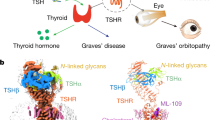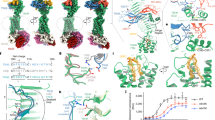Abstract
We have previously shown that a monoclonal antibody (MAb) recognizing the human growth hormone (hGH) antigenic domain left exposed after binding to lactogenic receptors enhanced hGH binding probably through allosteric effects on the hormone binding site. Since receptors displaying different specificities would not recognize exactly the same hGH region, we explored whether some of our MAb could affect hGH binding to somatogenic receptors from rabbit liver and to human liver hGH-specific receptors.
The effect of MAbAE5, AC8 and F11 on hGH binding was measured by determining the formation of125I-MAb:hGH:receptor complexes using two different experimental approaches. Results from procedure A, which involved the previous binding of the hormone to microsomes before adding125I-MAb, indicated that the hGH domain defined by epitopes AE5, AC8 and F11 is uncovered in the various hormone:receptor complexes.
Procedure B was devised to reveal any alteration in the hGH molecule induced by the MAb. In this case preformed125I-MAb:hGH complexes were added to microsomes. Data showed that125I-MAb AE5:hGH complexes bound better to the various receptors than125I-MAb AE5 to hGH:receptor complexes. On the contrary, hGH previously bound to125I-MAb AC8 or125I-MAb F11 was less recognized by the receptors than the free hormone. Furthermore, binding of MAb AE5 or MAb F11 to hGH 20 K (a natural hGH variant lacking residues 32–46) also enhanced its affinity to the various receptors whereas MAb AC8 did not inhibit hGH 20 K binding.
Results indicated that MAb recognizing the hGH antigenic area that remains unmasked after binding to different membrane-bound receptors are able to affect hormone binding site. MAb would induce either positive or negative allosteric changes in the hormone region involved in its binding to lactogenic, somatogenic and hGH-specific receptors.
Similar content being viewed by others
References
Roguin LP, Cohen CE, Retegui LA: Monoclonal antibodies as probes to study the human growth hormone binding domain to lactogenic rat liver receptors. Endocrinology 127:1009–1015, 1990
Cunningham BC, Jhurani P, Ng P, Wells JA: Receptor and antibody epitopes in human growth hormone identified by homolog-scanning mutagenesis. Science 243:1330–1336, 1989
Cunningham BC, Wells JA: Rational design of receptor-specific variants of human growth hormone. Proc Natl Acad Sci USA 88:3407–3411, 1991
De Vos AM, Ultsch M, Kossiakoff AA: Human growth hormone and extracellular domain of its receptor: crystal structure of the complex. Science 255:306–312, 1992
Spencer SA, Hammonds RG, Henzel WJ, Rodriguez H, Waters MJ, Wood WI: Rabbit liver growth hormone receptor and serum binding protein. Purification, characterization, and sequence. J Biol Chem 262:7862–7867, 1988
Hocquette J-F, Postel-Vinay M-C, Kayser C, de Hemptinne B, Amar-Costesec A: The human liver growth hormone receptor. Endocrinology 125: 2167–2174, 1989
Lewis UJ: Variants of growth hormone and prolactins and their posttranslational modifications. Ann Rev Physiol 46:33–42, 1984
Dellacha JM, Sonenberg M: Purification of bovine growth hormone. J Biol Chem 239:1515–1520, 1964
Roth J: Methods for assessing immunologic and biological properties of iodinated peptide hormones. In: S. O. Colowick and N. O. Kaplan (eds). Methods in Enzymology, vol 37, part B. Peptide Hormones, pp 223–228. Academic Press, New York, 1975
Mazza MM, Retegui LA: The antigenic topography of human growth hormone. Molec Immunol 26:231–240, 1989
Retegui LA, Milne RW, Cambiaso CL, Masson PL: The recognition by monoclonal antibodies of various portions of a major antigenic site of human growth hormone. Molec Immunol 19:865–875, 1982
Etcheverrigaray M, Paladini AC, Retegui LA: Stochastic humoral expression of human growth hormone epitopes. Immunology 63:595–601, 1988
Mazza MM, Gobet MG, Biscoglio MJ, Mihajlovich V, Guillemot FJ, Vita N, Ferrara P, Retegui LA: Relationship between the antigenic topography and the structure of human growth hormone. Endocrinology 127: 1002–1008, 1990
Ey PL, Prowse SJ, Jenkin CR: Isolation of pure IgG2a and IgG2b immunoglobulins from mouse serum using protein A-Sepharose. Immunochemistry 15:429–436, 1978
Mc Conahey PJ, Dixon FJ: A method of trace iodination of proteins for immunologic studies. Int Arch Allergy 29:185–189, 1966
Bonifacino JS, Sánchez SH, Paladini AC: Characterization of human somatotropin binding to detergent-solubilized lactogenic receptors from rat liver. Biochem J 194:385–394, 1981
Lowry OH, Rosebrough NJ, Farr AL, Randall RJ: Protein measurements with the folin phenol reagent. J Biol Chem 193:265–275, 1951
Paladini AC, Peña C, Poskus E: Molecular biology of growth hormone. In: J.G.R. Hurrell (ed.). CRC Critical Reviews in Biochemistry, CRC Press, Cleveland, Ohio, 15:25–56, 1983
Van Erp R, Gribnau TCJ, van Sommeren APG, Bloemers HPJ: Affinity of monoclonal antibodies. Interpretation of the positive cooperative nature of anti-hCH/hCG interactions. J Immunol Methods 140:235–241, 1991
Ehrlich PH, Moyle WR, Moustafa ZB, Canfield RE: Mixing two monoclonal antibodies yields enhanced affinity for antigen. J Immunol 128: 2709–2713, 1982
Diamond AG, Butcher GW, Howard JC: Localized conformational changes induced in a class I major histocompatibility antigen by the binding of monoclonal antibodies. J Immunol 132:1169–1175, 1984
Cunningham BC, Ultsch M, de Vos AM, Mulkerrin MG, Clauser KR, Wells JA: Dimerization of the extracellular domain of the human growth hormone receptor by a single hormone molecule. Science 254:821–825, 1991
Mazza MM, Retegui LA: Monoclonal antibodies to human growth hormone induce an allosteric conformational change in the antigen. Immunology 67: 148–153, 1989
Author information
Authors and Affiliations
Rights and permissions
About this article
Cite this article
Aguilar, R.C., Retegui, L.A., Postel-Vinay, MC. et al. Allosteric effects of monoclonal antibodies on human growth hormone. Mol Cell Biochem 136, 35–42 (1994). https://doi.org/10.1007/BF00931602
Received:
Accepted:
Issue Date:
DOI: https://doi.org/10.1007/BF00931602




